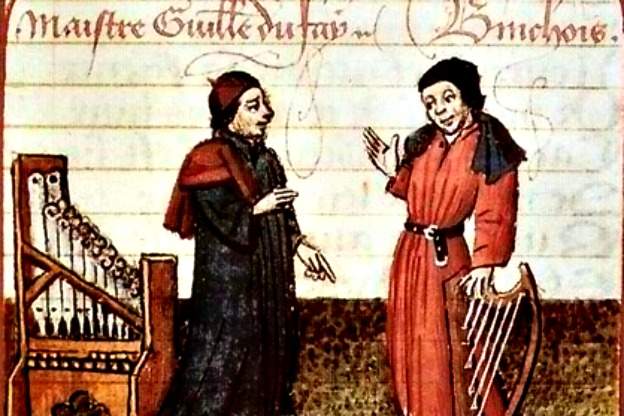
Shortly before the end of his life, chronicler Jean Froissart completed his fourth and final book recounting events from the 14th century. Froissart’s chronicle detailed his experience of ongoing tensions between England and France, noting the reigns of Edward III and Charles IV. Froissart provided eye-witness accounts of major battles, in addition to scenes from ordinary life at the time of the Great Schism and Black Death. The text of Froissart’s Chronicles is believed to be preserved in over one hundred manuscripts.
In England, Geoffrey Chaucer died of unknown causes in October of 1400. Chaucer composed numerous essays and poems over the lengthy and well-traveled course of his career. These include The House of Fame and The Legend of Good Women, two poems recounting dream visions. Chaucer drafted a translation of the medieval French Roman de la Rose and wrote for his son a treatise on the astrolabe, an early astronomical device used to calculate to positions of celestial bodies.
In 1374 Chaucer’s lord and patron, Edward III, celebrated his literary ability by awarding the poet one gallon of wine per day for the rest of his life. Chaucer was buried at the south transept of Westminster Abbey, a place that would later be titled Poet’s Corner. His best known work, The Canterbury Tales, was unfinished at the time of his death.
Two artists were born in 1400. Luca della Robbia was a Florentine sculptor whose work is noted for the charm and simplicity of its depicted scenes. He also developed a pottery glaze that made sculptures more durable and suitable for outdoor display. Author Leon Battista Alberti praised della Robbia, comparing his work to that by Filippo Brunelleschi, architect for the Duomo, and the sculptor Donatello.
Like della Robbia, Flemish painter Rogier van der Weyden enjoyed a successful artistic career. His religious tryptichs travelled as far as Italy and Spain, bolstering his reputation as a painter on par with Jan van Eyck. Van der Weyden is believed to have completed his most famous work, The Descent from the Cross, in 1453. The harrowing depiction of Christ’s deposition was emulated by numerous artists. Centuries later, art historian Otto Von Simson claimed: "No other painting of its school has been copied or adapted so often."
The year 1400 also saw the birth of Burgundian composer Gilles Binchois. Binchois first worked as an organist for the church of Ste. Waudru (Saint Waltrude) in his hometown of Mons, in what’s now Belgium. After a brief period of employment as a soldier, he joined the court chapel of Burgundy, serving as both singer and composer. Like many musicians, details from Binchois’s life can be ascertained from the compositions themselves. A motet crafted at the court of Burgundy lists the names of singers with which Binchois worked. Similarly, a lament on Binchois’s death written by Johannes Ockeghem alludes to the late composer’s achievements.
Although typically ranked behind contemporary composers such as Guillaume Dufay and John Dunstaple, the extent of Binchois’s musical influence is undeniable. His melodies were cited and borrowed more often than those by any other composer of his time.









